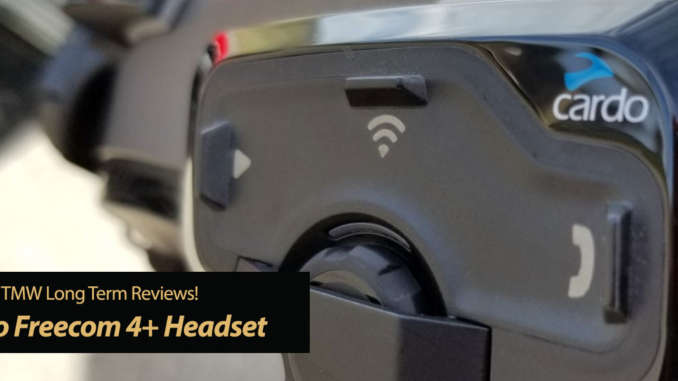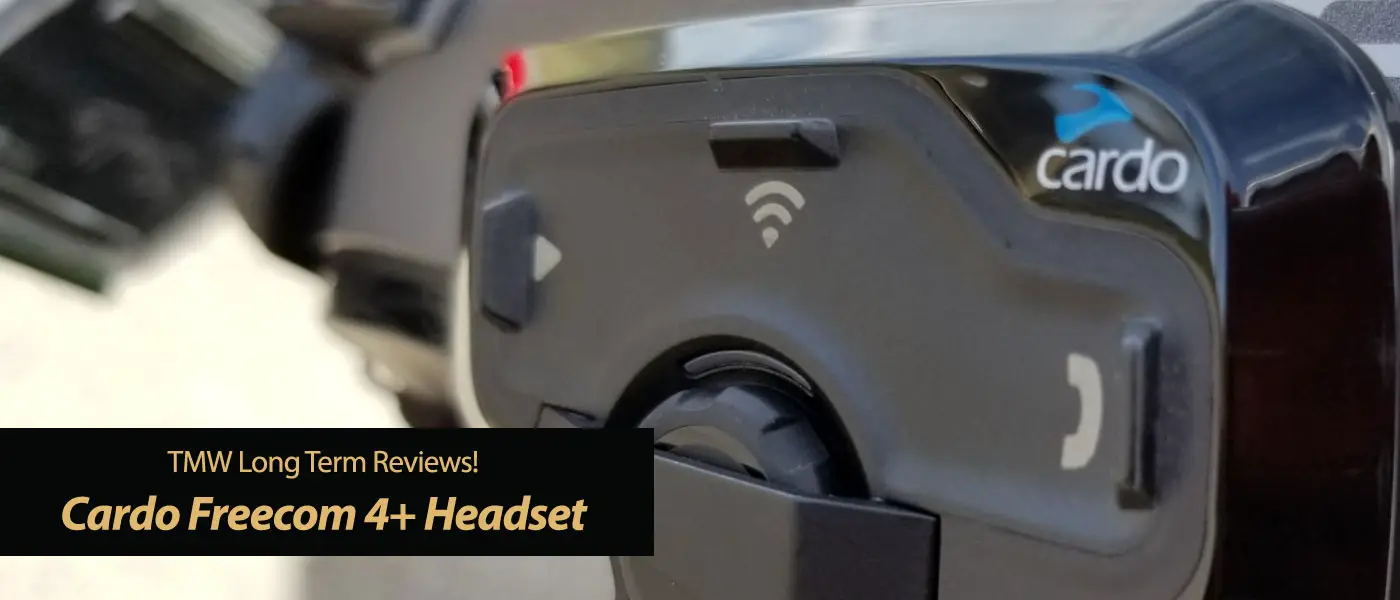
Rider-to-Rider communication is becoming a very competitive market. With dozens of options and a growing list of features, it can be hard to separate the gold from the gimmicks. Voice control, cross-brand integration, POV cameras, built-ins, there’s a lot to sift through. Total Motorcycle got a chance to review the latest from Cardo, the Freecom 4+. Come see what we thought of it.
Cardo 4+ Helmet Communications System
| Reviewed By: | Eric and Carrie Leaverton |
| Review Dates: | April 1 2019 to June 1 2019 |
| Price As Tested: | $375.00 USD |
OVERVIEW
The Cardo 4+ rider-to-rider communications system is an intercom and media headset built on Bluetooth architecture. It consists of the unit itself, a cradle, and speakers and a microphone that install inside the helmet. The cradle installs to the outside of the helmet, and the unit detaches from the cradle for charging and security.
The system offers native communication between itself and up to three other Cardo 4+ units. Two Bluetooth channels allow you to pair to two devices, such as a smart phone and a GPS. FM radio is also supported. Most of these features can be engaged with voice commands, which we’ll cover in-depth later on.
Other features include audio sharing, phone call integration with the intercom, and compatibility with other premium headset brands. There’s also volume attenuation to compensate for ambient noise, noise cancellation, in-use charging, and app support. We’ll cover all these features in detail in the following paragraphs.
The device has four primary controls, MEDIA, PHONE, and INTERCOM buttons, and a control wheel. The control wheel accepts several different types of inputs, including clicking, rolling forwards and backwards, and rolling forwards and backwards while depressed. Each performs a different function.
CARDO 4+ INSTALLATION
Speakers
We installed our Cardo 4+ units on my LS2 Stream and Carrie’s Scorpion EXO-T510. Both of these helmets are designed to receive headsets. They have pockets behind the cheek pads for placing speakers, and a mesh membrane that covers the speakers without muting them. This made installation easier than it might have been with other helmets. The speakers are connected by a wire long enough for any helmet size you’re using. Our installations ended up with plenty of slack length.
Microphone
Out of the package, the system supports full-face, modular, or 3/4 helmets. For full-face helmets, Cardo included a wired microphone with Velcro fasteners. Cardo included a boom mic on a flexible 7″ loom for modular or 3/4 helmets. You can install the system in half helmets, but you’ll have to buy an accessory cradle for the mic to accomplish it.
We used the wired pad, as both our helmets have a solid chin bar. My helmet has quilted padding on the inside of the chin bar, but the Velcro pads adhered to it just fine and hasn’t budged. Carrie’s helmet is smooth plastic on the inside of the chin bar, so no drama there. As with the speaker kit, there was plenty of slack wire leftover.
Exterior Cradle
For the cradle, the Cardo 4+ offers either a clip-type installation or a glue pad. We both used the clip type, and they work well, but here I’d like to offer some advice. Just commit to your intercom and use the glue pad. Modern helmet use collar padding with semi-rigid retention piping, and trying to wedge the clip in over all that is challenging. You probably wont get the rim put together the right way with that clip there, and at best it’ll be unsightly. At worst, you’re liable to break some component of your helmet and your padding may not fit right again. So just use the glue pad.
The unit clips into the cradle with tabs and a button. Press and lift to remove, press and press to reinstall. This allows you to easily and quickly disconnect the unit without disturbing any of the other components.

PERFORMANCE
First, a note. I want to be very clear about exactly what it is the Cardo 4+ does, and doesn’t do. I think that’s extremely important when discussing how well it works.
I’ve seen a lot of reviewers trash a headset because it wont reliably switch back and forth from navigation prompts to streaming music. Or because it searches for every Hyatt Regency, instead of the one closest them. Or because they can’t select a particular artist from their music library.
Complaints of this nature are, quite simply, erroneous. The headset just isn’t in charge of these features. All that stuff is dependent on how you have your phone configured and how well your voice assistant works. All the headset can do is tell the voice assistant what you said, and it’s the phone itself handling the rest. The moment you say “Okay Google,” or “Hey, Siri,” your headset is no longer doing anything but transmitting audio.
Because of this, I’m not going to discuss how well Okay Google works for us. It’s just not relevant to the functions of the Cardo 4+. The only thing I will say is that the Cardo recognizes the phase “Okay Google” about 90% of the time and activates the voice assistant on our phones. We both carry Samsung Galaxy S8 phones, running Android 9.0 and kernel 4.4.153.
So, let’s move on.
Form Factor
The physical design of the Cardo 4+ is very well done. The three function buttons are laid out in such a way they’re easy to distinguish from one another, even with gloves on. They’re chunky and have a firm, positive click when pressed.
The wheel is less well executed. It hangs down below the unit, and in that location it’s susceptible to accidental inputs.
The unit is attractive and feels very well made. All the seams are clean and tight, and the clip acts as a cord management system as well. Once installed, it’s a small, tidy package.

“The physical design of the Cardo 4+ is very well done.”
Speaker Volume and Clarity
Cardo did what we all do when we absolutely, positively have to get something right.
They called an expert.
The speaker set for the Cardo 4+ was designed and manufactured by JBL Audio, a world leader in speaker technology. Cardo and JBL partnered for this, and the results speak for themselves.
The 40mm speakers really do an outstanding job of delivering stereo sound inside the helmet. Around town, my music has as much texture and nuance as I could expect from any stereo headset. This is true at any speed below about 65-70 mph. Above that, I loose some of the low range, but the music stays perfectly audible. This remains true all the way up to triple digits. This is also true for the intercom. Carrie and I can hear each other very well, even at high speeds in windy canyons. Please check out the supplemental video review for a great demonstration of this.
I should mention that this is even when riding with earplugs, which we do on any ride longer than a couple of minutes.
Intercom and Microphone
The intercom performs amazingly well. We have other headsets, and they’re alright to signal a bathroom break or relay directions, but they’re no good for sustained conversation. The Cardo, though, doesn’t miss a beat. We can talk back and forth about any topic, in any detail, without ever having to ask each other to repeat something or puzzle though some garbled speech.
The intercom does an impressive job of noise cancellation too. Background wind, engine noise, and ambient traffic sounds get filtered out, and the system only transmits when it recognizes overt input. This is usually good, but loose helmet straps or jackets buckles can quickly become an ordeal. If you have anything flapping around, the intercom will interpret the impacts as speech and send a barrage of clicks and booms to your partner.
Here, though, a fatal flaw is revealed. For some reason, our headsets will randomly terminate the intercom connection. At first, we though we were bumping the control wheel with our shoulders when looking left. Careful observation disproved this theory though. More on the wheel later. Then we thought maybe something about the Bluetooth connection to our phones was stealing audio focus. A few miles with our phones turned off proved that wrong too.
It’s easy enough to reconnect them when it happens, a push of the INTERCOM button or a voice command and we’re right back on intercom. But it’s frequent and pervasive, as often as once every two or three minutes, and it happens in all environments and at all speeds. It’s a critical failure of an otherwise outstanding product.
Telephone
When paired with a smartphone, the Cardo 4+ offers a lot of telephone functionality.
Receiving Calls
Incoming calls can be answered by either clicking the control wheel once, or by voice with the command “Answer”. An incoming call can be rejected by pressing and holding any of the three function buttons for two seconds. You can also ignore a call by jogging the control wheel back and forward, or with the voice command “Ignore.”
Placing Calls
You can use your voice assistant to place calls, and results will vary based on how well that feature works on your phone. The Cardo 4+ doesn’t pull in address book or contact information. Otherwise, you can redial the last number called on your phone with either a double-tap of the PHONE function button, or with the voice command “Hey Cardo, redial number.” Finally, you can set one speed dial number in the Cardo app, and dial it with either a long press of the PHONE button, or the command “Hey Cardo, speed dial.”
On A Call
During a phone call, the same speaker and microphone performance outlined earlier still applies. I’ve carried on conversations with people who were completely oblivious, even at freeway speeds. The connection between the headset and the phone was reliable and robust.
Ending A Call
A quick tap of the PHONE or MEDIA buttons, or a press of the Wheel, will end a call in progress. There is no voice command to end a call.
VOICE COMMANDS
This is another gold star for the Cardo 4+. It recognizes the commands virtually all the time, so you rarely have to repeat yourself. What follows is a list of functions and the voice command that performs them:
Turn on the radio: “Hey Cardo, radio on”
Turn off the radio: “Hey Cardo, radio off”
Skip to the next preset radio station: “Hey Cardo, next station”
Skip to the previous preset radio station: “Hey Cardo, previous station”
Turn on music (streaming audio source): “Hey Cardo, music on”
Turn off music: (streaming audio source): “Hey Cardo, music off”
Play the next music track (streaming audio source): “Hey Cardo, next track”
Play the previous music track (streaming audio source): “Hey Cardo, previous track”
Raise volume: “Hey Cardo, volume up”
Lower volume: “Hey Cardo, volume down”
Mute audio: “Hey Cardo, mute audio”
Unmute audio: “Hey Cardo, unmute audio”
Call the default number (configurable): “Hey Cardo, speed dial”
Redial the last number: “Hey Cardo, redial number”
Answer an incoming call: “Answer”
Ignore an incoming call: “Ignore”
Access Siri (when connected to an iOS device): “Hey Siri”
Access Google (when connected to an Android
device): “OK Google”
Check the battery status: “Hey Cardo, battery status”
Open the call intercom: “Hey Cardo, call intercom”
Inexplicably, there is no voice command to terminate an intercom call. It’s easy enough to do with a quick press of the INTERCOM button, but there really ought to be a voice command for it. Carrie and I will switch back and forth from intercom to music several times on a ride, and we’re acutely aware of this shortcoming.
“It recognizes the commands virtually all the time, so you rarely have to repeat yourself.”
One more important aspect of the voice commands to mention is language support. Besides English, the Cardo 4+ can support the following languages for voice control:
Spanish
French
German
Italian
Portuguese
Russian
Japanese
Chinese
Hebrew
GROUP PAIRINGS
Carrie and I are just two riders, and during the course of this review we didn’t have the opportunity to pair with multiple riders using either Cardo or non-Cardo products. As such, the following is just an explanation of how this function would work as explained in the manuals.
Cardo
As the name suggests, the Cardo 4+ can connect up to four riders simultaneously. It’s possible to initiate a private conversation between any two riders in the pairing group, connect only three in a call, or get all four riders in a single call, depending on how you chain the calls together. It’s important to note, under certain conditions in a three or four way call, some of the riders may be using both available Bluetooth channels on their headset. Those riders will be unable to receive calls from their paired mobile phones while the intercom call is active.
Non-Cardo
All the same things are true when paired with non-Cardo product users, but there may be complications depending on how many Bluetooth channels are available on the other devices. The Cardo units will connect to the other devices as a cellular phone. Results may vary when using this functionality.
AUDIO SHARING
This is a feature we were very excited to use, and one that we sorely missed on our last unit, the SCS S1. While listening to streaming media from your audio source, you can press and hold the INTERCOM button to initiate sharing with your partner. The unit will stream your audio source to their headset as well, including music and navigation prompts. When sharing FM radio, you can every carry on and intercom call over the music. That doesn’t work with Bluetooth streaming though.
APP INTEGRATION
Cardo offers an app that pairs with your device, and this creates a new level of functionality for the device. In the app you can switch between audio sources, initiate sharing, tune and preset your FM radio, perform firmware updates and fiddle with dozens of other settings. You can also adjust the volume, pause, play, and skip, and use the phone features such as Redial and Speed Dial. If you’re the sort of rider who has your cell phone accessible in a mount when you ride, the app is another good option for controlling the device.
CONCLUSIONS ON THE CARDO 4+
The Cardo 4+ is an incredibly well engineered device. In raw function and features, it really does get most things right.
Speaker volume and clarity is impeccable, even at freeway speeds. Connection to your partner rider is quick, automatic, and reliable, and the intercom transmission is flawless. Voice commands work very well, which allows you to keep your hands where they should be instead of messing with the device. If that was all there was to the story, this would be a home run.
Unfortunately, the intercom dropping out like it does is simply unacceptable. Especially at this price point. If it was a simple problem of accidental input, that would be easy enough to compensate for. But there’s something more going on. After the third or fourth instance of a dropped intercom in ten minutes, we’re ready to give up on talking and just stick with music. For the lone rider this wouldn’t be an issue, or for two people who only rarely and briefly use the intercom. Actually, that might be even worse, since it’s liable to be an important conversation in cases like that.
I’m hoping this is a simple thing to fix, and we stand ready to revise our conclusions immediately once the source of the problem is identified and remedied. Until then, though, we can only offer the Total Motorcycle Silver award, Three Stars.
Hey Cardo, firmware update?





